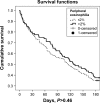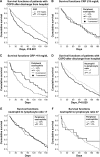The utility of inflammatory markers to predict readmissions and mortality in COPD cases with or without eosinophilia
- PMID: 26648709
- PMCID: PMC4648601
- DOI: 10.2147/COPD.S90330
The utility of inflammatory markers to predict readmissions and mortality in COPD cases with or without eosinophilia
Erratum in
-
Erratum: The utility of inflammatory markers to predict readmissions and mortality in COPD cases with or without eosinophilia [Corrigendum].Int J Chron Obstruct Pulmon Dis. 2016 Mar 1;11:417. doi: 10.2147/COPD.S103721. eCollection 2016. Int J Chron Obstruct Pulmon Dis. 2016. PMID: 27013872 Free PMC article.
Abstract
Background: COPD exacerbations requiring hospitalization increase morbidity and mortality. Although most COPD exacerbations are neutrophilic, approximately 10%-25% of exacerbations are eosinophilic.
Aim: We aimed to evaluate mortality and outcomes of eosinophilic and non-eosinophilic COPD exacerbations and identify new biomarkers that predict survival.
Methods: A retrospective observational cohort study was carried out in a tertiary teaching hospital from January 1, 2014 to November 1, 2014. All COPD patients hospitalized with exacerbations were enrolled in the study at their initial hospitalization and followed-up for 6 months after discharge. Electronic data were collected from the hospital database. Subjects' characteristics, hemogram parameters, CRP levels, neutrophil-to-lymphocyte ratio (NLR), platelet-to-mean platelet volume ratio on admission and discharge, length of hospital stay (days), readmissions, and mortality were recorded. Patients were grouped according to peripheral blood eosinophil (PBE) levels: Group 1, >2% PBE, eosinophilic; Group 2, non-eosinophilic ≤2%. Patient survival after hospital discharge was evaluated by Kaplan-Meier survival analysis.
Results: A total of 1,704 patients hospitalized with COPD exacerbation were included. Approximately 20% were classified as eosinophilic. Six-month mortality was similar in eosinophilic and non-eosinophilic groups (14.2% and 15.2%, respectively); however, the hospital stay length and readmission rate were longer and higher in the non-eosinophilic group (P<0.001 and P<0.01, respectively). CRP and NLR were significantly higher in the non-eosinophilic group (both P<0.01). The platelet-to-mean platelet volume ratio was not different between the two groups. Cox regression analysis showed that survival was negatively influenced by elevated CRP (P<0.035) and NLR (P<0.001) in the non-eosinophilic group.
Conclusion: Non-eosinophilic patients with COPD exacerbations with high CRP and NLR values had worse outcomes than eosinophilic patients. PBE and NLR can be helpful markers to guide treatment decisions.
Keywords: chronic obstructive pulmonary disease; exacerbation; mortality; peripheral eosinophilia.
Figures



References
-
- Global Initiative for Chronic Obstructive Lung Disease [homepage on the Internet] Global strategy for diagnosis, management, and prevention of COPD [updated 2012] [Accessed October 5, 2015]. Available from: http://www.goldcopd.org.
-
- Singanayam A, Schembri S, Chalmers JD. Predictors of mortality in hospitalized adults with acute exacerbation of chronic obstructive pulmonary disease. A systematic review and meta-analysis. Ann Am Thorac Soc. 2013;10(2):81–89. - PubMed
-
- Brightling CE. Biomarkers that predict and guide therapy for exacerbations of chronic obstructive pulmonary disease. Ann Am Thorac Soc. 2013;10(Suppl):S214–S219. - PubMed
-
- Tertemiz KC, Kömüs N, Ellidokuz H, Sevinç C, Cımrın AH. Kronik obstrüktif akciğer hastalığında mortalite ve mortaliteyi etkileyen faktörler [Mortality and factors affecting mortality in chronic obstructive pulmonary disease] Tuberk Toraks. 2012;60(2):114–122. Turkish. - PubMed
-
- Gunen H, Hacievliyagil SS, Kosar F, et al. Factors affecting survival of hospitalized patients with COPD. Eur Respir J. 2005;26(2):234–241. - PubMed
Publication types
MeSH terms
Substances
LinkOut - more resources
Full Text Sources
Medical
Research Materials
Miscellaneous

